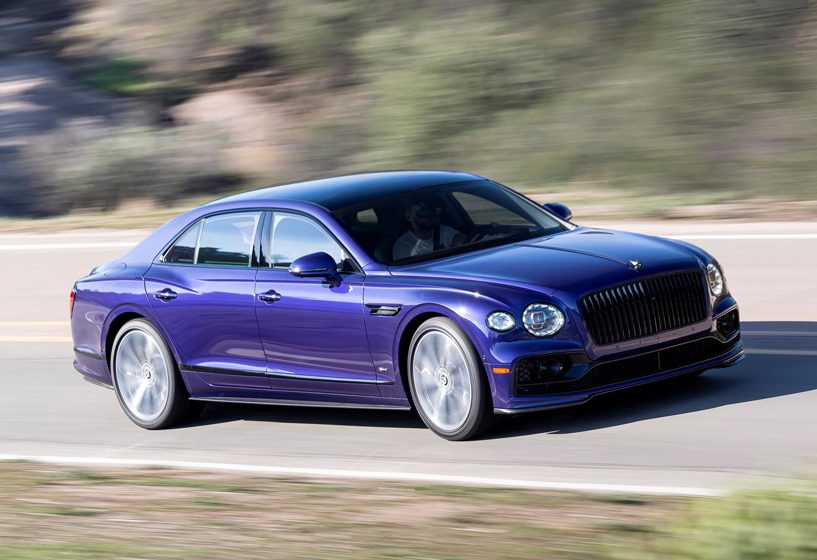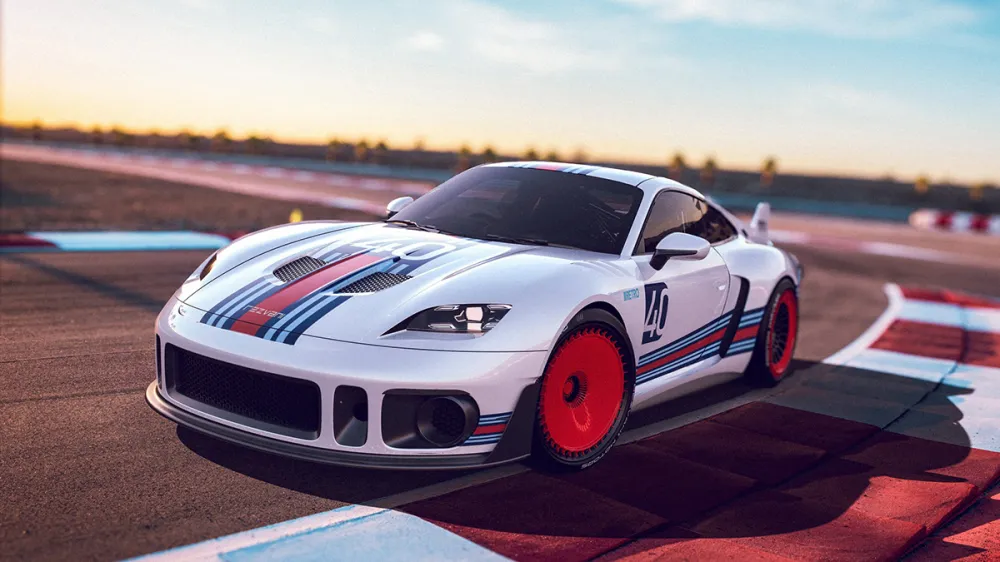
Robb Review: Bentley Flying Spur Hybrid
The sedan still has to convert the marque’s 12-cylinder faithful.
Related articles
W.O. Bentley, founder of the eponymous 102-year-old automaker, once proclaimed, “I have always wanted to produce a dead silent 100mph (160km/h) car, and now I think that we have done it.” He was referring to the gas-combusting 1930 Bentley 8 Litre model, but, 92 years later, the comment has become more prescient with the badge’s new 394kW Bentley Flying Spur Hybrid.
The move to hybridisation—and, soon, zero-emission vehicles only—is part of Bentley’s “Beyond 100” plan announced in 2020, which mandates a complete discontinuation of the internal combustion engine (ICE) over the next eight years. The second model in the lineup to go plug-in following the Bentayga Hybrid, this Flying Spur heralds from a prestigious lineage that began in the 1950s with the Mulliner-dressed S1 Continental Flying Spur that was initially powered by a 4.9-litre straight-six engine. Subsequent iterations carried a V-8 powerplant until production ended in 1965. But with the new century came a new lease on life, with the moniker reborn in 2005 attached to a W-12 engine and, later, completely revised for the 2019 model year.

Bentley’s Flying Spur Hybrid in Azure Purple. Photo by James Lipman, courtesy of Bentley Motors Limited.
This hybrid is pivotal for Bentley’s future direction. Pulling away from the Peninsula Beverly Hills, in Los Angeles, I was curious how a battery-enhanced Flying Spur, decked in lustrous Azure Purple garb, measures up to a direct competitor like the redesigned Rolls-Royce Ghost or even the less-expensive Mercedes-Benz S-Class. Most importantly, would there be a sacrifice in performance when compared to Bentley’s own ICE-powered lineup?

With its fully charged 1.4 kWh lithium-ion battery and a tank of fuel, the car has nearly a 700km range. Photo by James Lipman, courtesy of Bentley Motors Limited.
Navigating through the City of Angels and onto the 101 Freeway, the Flying Spur nimbly danced between the three E Modes, or battery-management settings, including EV Drive, Hybrid Mode and Hold Mode. During urban sections, EV Drive emphasizes the 98kW electric motor (juiced by a 1.4 kWh lithium-ion battery) while the Hybrid selection also includes the V-6 for extended travel, though I couldn’t sort which was at work when; it’s only in Hold Mode, designed to conserve battery charge, that the 2.9-litre V-6 is clearly dominant. In all, the hybrid configuration is claimed to be good for a nearly 700km range.

The hybrid version of the Flying Spur still sports the same sumptuous cabin that earned Robb Report’s Best of the Best accolade for interiors last year. Photo by James Lipman, courtesy of Bentley Motors Limited.
But why a V-6? I posed the question to Steve Jones, Bentley’s chief technical engineer for the Continental GT, GTC and Flying Spur. His response was diplomatic, saying that “the only available power train for that particular car is the V-6 PZEV engine” without mentioning that Volkswagen Group stablemate Porsche also utilizes a 2.9-liter twin-turbo V-6 in its Macan model line. Jones, however, was candid describing the greatest challenge for this model variant: “Our customers expect effortless power delivery, and of course that’s easy to do with a W-12 engine that’s capable of 650 bhp (478kW) and 950Nm of torque.” So while “the V-6 is obviously a much lower power derivative,” he adds that “by combining it with the e-motor [the engine] can deliver an equivalent power output as that of our current V-8.”

The 2.9-litre V-6 and electric motor combine for 394kW and 750Nm of torque. Photo by Kelly Serfoss, courtesy of Bentley Motors Limited.
Tracing circuitous State Route 150 around Lake Casitas to Ojai, just south of Santa Barbara, I switch from Bentley mode, the comfort setting, to Sport, briefly hammering the throttle to tap into the 750Nm of torque. I’m met with acceleration akin to a winded sprinter straining for the finish line, the engine seeming to grasp for a next gear that just wasn’t quite there, an apt description of the overall performance, at least compared to Bentley’s own athletic Continental, or competitors such as the Rolls-Royce Black Badge Ghost.

Exploring one of Malibu’s canyon roads at dusk. Photo by James Lipman, courtesy of Bentley Motors Limited.
On the turns, the 2505kg all-wheel-drive four-door doesn’t hide its heft as much as expected, and I found that the benefit of all-wheel steering was less apparent than in, say, an S-Class. Still, the machine covers zero to 97km/h in 4.1 seconds and tops out at 284km/h —certainly no slouch in the spec department. And the chassis benefits from double-wishbone suspension at the front and a multi-link setup at the rear, along with three-chamber air springs that are claimed to provide 60 per cent more volume than before. Its prodigious stopping power is owed to what Bentley touts as “the largest iron brakes in the world,” at 16.5 inches in diameter. Yet despite the significant engineering feats, the Flying Spur Hybrid simply lacks enough muscle for its mass. The impressive shape seems rife with athletic potential, but the large hybrid sedan simply hasn’t fully come into its own yet in terms of performance.

The all-wheel-drive four-door has a curb weight of 2505kg. Photo by James Lipman, courtesy of Bentley Motors Limited.
But when it comes to aesthetics, the model certainly belongs in the winner’s circle. The wheelbase’s 5.11-inch extension, along with our example’s optional 22-inch, Mulliner-spec wheels added to the gravitas of both the silhouette and stance, as does the newly illuminated Flying B hood ornament. But, as expected, it’s the Flying Spur’s interior that truly charges the senses. From unseen details like the knurled surface treatment behind the door handles to the innovative rotating dashboard display to the 3-D diamond-quilted door and panel inserts, the hybrid still has it all in the high-touch style department.

Our Azure Purple example’s inner sanctum is defined by Damson and Porpoise leather as well as 3-D diamond-quilted upholstery and panelling. Photo by James Lipman, courtesy of Bentley Motors Limited.
“Hybrid in America, for Bentley, is obviously quite new,” says Christophe Georges, president and CEO of Bentley Americas. “[Customers] need to try it, to test it, and then we will be able to assess what will be the share. But if you look at the overall market for hybrid, it has developed considerably last year in America, so we should see the same kind of development happen with us.” Though, in a pragmatic nod, he concedes that “maybe it’s not the same proportions, but we’ll see.”

Pricing for the model variant has yet to be confirmed in Australia. Photo by James Lipman, courtesy of Bentley Motors Limited.
These are reasonable expectations for a new hybrid model, and only Bentley’s second attempt at the form. The Flying Spur Hybrid, while offering as baronial a passenger experience as any Bentley, is a beautifully appointed stopgap, yet it also represents for the brand a vitally necessary step toward the most significant transformation in automotive history.
Subscribe to the Newsletter
Recommended for you
8 Fascinating Facts You Didn’t Know About Aston Martin
The British sports car company is most famous as the vehicle of choice for James Bond, but Aston Martin has an interesting history beyond 007.
May 1, 2024
Rezvani Will Rebuild Your 911 to Go From Zero to 100 in Two Seconds
The shop will build a version of the RR1 based on the Carrera S, GT3, and Turbo S
By Bryan Hood
April 23, 2024
You may also like.
You may also like.
Watch of the Week: TAG Heuer Formula 1 | Kith
The legendary sports watch returns, but with an unexpected twist.
Over the last few years, watch pundits have predicted the return of the eccentric TAG Heuer Formula 1, in some shape or form. It was all but confirmed when TAG Heuer’s heritage director, Nicholas Biebuyck, teased a slew of vintage models on his Instagram account in the aftermath of last year’s Watches & Wonders 2023 in Geneva. And when speaking with Frédéric Arnault at last year’s trade fair, the former CEO asked me directly if the brand were to relaunch its legacy Formula 1 collection, loved by collectors globally, how should they go about it?
My answer to the baited entreaty definitely didn’t mention a collaboration with Ronnie Fieg of Kith, one of the world’s biggest streetwear fashion labels. Still, here we are: the TAG Heuer Formula 1 is officially back and as colourful as ever.
As the watch industry enters its hype era—in recent years, we’ve seen MoonSwatches, Scuba Fifty Fathoms, and John Mayer G-Shocks—the new Formula 1 x Kith collaboration might be the coolest yet.

Here’s the lowdown: overnight, TAG Heuer, together with Kith, took to socials to unveil a special, limited-edition collection of Formula 1 timepieces, inspired by the original collection from the 1980s. There are 10 new watches, all limited, with some designed on a stainless steel bracelet and some on an upgraded rubber strap; both options nod to the originals.
Seven are exclusive to Kith and its global stores (New York, Los Angeles, Miami, Hawaii, Tokyo, Toronto, and Paris, to be specific), and are made in an abundance of colours. Two are exclusive to TAG Heuer; and one is “shared” between TAG Heuer and Kith—this is a highlight of the collection, in our opinion. A faithful play on the original composite quartz watch from 1986, this model, limited to just 1,350 pieces globally, features the classic black bezel with red accents, a stainless steel bracelet, and that creamy eggshell dial, in all of its vintage-inspired glory. There’s no doubt that this particular model will present as pure nostalgia for those old enough to remember when the original TAG Heuer Formula 1 made its debut.

Of course, throughout the collection, Fieg’s design cues are punctuated: the “TAG” is replaced with “Kith,” forming a contentious new brand name for this specific release, as well as Kith’s slogan, “Just Us.”
Collectors and purists alike will appreciate the dedication to the original Formula 1 collection: features like the 35mm Arnite cases—sourced from the original 80s-era supplier—the form hour hand, a triangle with a dot inside at 12 o’clock, indices that alternate every quarter between shields and dots, and a contrasting minuterie, are all welcomed design specs that make this collaboration so great.
Every TAG Heuer Formula 1 | Kith timepiece will be presented in an eye-catching box that complements the fun and colour theme of Formula 1 but drives home the premium status of this collaboration. On that note, at $2,200 a piece, this isn’t exactly an approachable quartz watch but reflects the exclusive nature of Fieg’s Kith brand and the pieces he designs (largely limited-edition).

So, what do we think? It’s important not to understate the significance of the arrival of the TAG Heuer Formula 1 in 1986, in what would prove integral in setting up the brand for success throughout the 90’s—it was the very first watch collection to have “TAG Heuer” branding, after all—but also in helping to establish a new generation of watch consumer. Like Fieg, many millennial enthusiasts will recall their sentimental ties with the Formula 1, often their first timepiece in their horological journey.
This is as faithful of a reissue as we’ll get from TAG Heuer right now, and budding watch fans should be pleased with the result. To TAG Heuer’s credit, a great deal of research has gone into perfecting and replicating this iconic collection’s proportions, materials, and aesthetic for the modern-day consumer. Sure, it would have been nice to see a full lume dial, a distinguishing feature on some of the original pieces—why this wasn’t done is lost on me—and perhaps a more approachable price point, but there’s no doubt these will become an instant hit in the days to come.
—
The TAG Heuer Formula 1 | Kith collection will be available on Friday, May 3rd, exclusively in-store at select TAG Heuer and Kith locations in Miami, and available starting Monday, May 6th, at select TAG Heuer boutiques, all Kith shops, and online at Kith.com. To see the full collection, visit tagheuer.com
You may also like.
8 Fascinating Facts You Didn’t Know About Aston Martin
The British sports car company is most famous as the vehicle of choice for James Bond, but Aston Martin has an interesting history beyond 007.
Aston Martin will forever be associated with James Bond, ever since everyone’s favourite spy took delivery of his signature silver DB5 in the 1964 film Goldfinger. But there’s a lot more to the history of this famed British sports car brand beyond its association with the fictional British Secret Service agent.
Let’s dive into the long and colourful history of Aston Martin.
You may also like.
What Venice’s New Tourist Tax Means for Your Next Trip
The Italian city will now charge visitors an entry fee during peak season.
Visiting the Floating City just got a bit more expensive.
Venice is officially the first metropolis in the world to start implementing a day-trip fee in an effort to help the Italian hot spot combat overtourism during peak season, The Associated Press reported. The new program, which went into effect, requires travellers to cough up roughly €5 (about $AUD8.50) per person before they can explore the city’s canals and historic sites. Back in January, Venice also announced that starting in June, it would cap the size of tourist groups to 25 people and prohibit loudspeakers in the city centre and the islands of Murano, Burano, and Torcello.
“We need to find a new balance between the tourists and residents,’ Simone Venturini, the city’s top tourism official, told AP News. “We need to safeguard the spaces of the residents, of course, and we need to discourage the arrival of day-trippers on some particular days.”
During this trial phase, the fee only applies to the 29 days deemed the busiest—between April 25 and July 14—and tickets will remain valid from 8:30 am to 4 pm. Visitors under 14 years of age will be allowed in free of charge in addition to guests with hotel reservations. However, the latter must apply online beforehand to request an exemption. Day-trippers can also pre-pay for tickets online via the city’s official tourism site or snap them up in person at the Santa Lucia train station.
“With courage and great humility, we are introducing this system because we want to give a future to Venice and leave this heritage of humanity to future generations,” Venice Mayor Luigi Brugnaro said in a statement on X (formerly known as Twitter) regarding the city’s much-talked-about entry fee.
Despite the mayor’s backing, it’s apparent that residents weren’t totally pleased with the program. The regulation led to protests and riots outside of the train station, The Independent reported. “We are against this measure because it will do nothing to stop overtourism,” resident Cristina Romieri told the outlet. “Moreover, it is such a complex regulation with so many exceptions that it will also be difficult to enforce it.”
While Venice is the first city to carry out the new day-tripper fee, several other European locales have introduced or raised tourist taxes to fend off large crowds and boost the local economy. Most recently, Barcelona increased its city-wide tourist tax. Similarly, you’ll have to pay an extra “climate crisis resilience” tax if you plan on visiting Greece that will fund the country’s disaster recovery projects.
You may also like.
Omega Reveals a New Speedmaster Ahead of the Paris 2024 Olympics
Your first look at the new Speedmaster Chronoscope, designed in the colour theme of the Paris Olympics.
The starters are on the blocks, and with less than 100 days to go until the Paris 2024 Olympics, luxury Swiss watchmaker Omega was bound to release something spectacular to mark its bragging rights as the official timekeeper for the Summer Games. Enter the new 43mm Speedmaster Chronoscope, available in new colourways—gold, black, and white—in line with the colour theme of the Olympic Games in Paris this July.
So, what do we get in this nicely-wrapped, Olympics-inspired package? Technically, there are four new podium-worthy iterations of the iconic Speedmaster.

The new versions present handsomely in stainless steel or 18K Moonshine Gold—the brand’s proprietary yellow gold known for its enduring shine. The steel version has an anodised aluminium bezel and a stainless steel bracelet or vintage-inspired perforated leather strap. The Moonshine Gold iteration boasts a ceramic bezel; it will most likely appease Speedy collectors, particularly those with an affinity for Omega’s long-standing role as stewards of the Olympic Games.
Notably, each watch bears an attractive white opaline dial; the background to three dark grey timing scales in a 1940s “snail” design. Of course, this Speedmaster Chronoscope is special in its own right. For the most part, the overall look of the Speedmaster has remained true to its 1957 origins. This Speedmaster, however, adopts Omega’s Chronoscope design from 2021, including the storied tachymeter scale, along with a telemeter, and pulsometer scale—essentially, three different measurements on the wrist.
While the technical nature of this timepiece won’t interest some, others will revel in its theatrics. Turn over each timepiece, and instead of a transparent crystal caseback, there is a stamped medallion featuring a mirror-polished Paris 2024 logo, along with “Paris 2024” and the Olympic Rings—a subtle nod to this year’s games.
Powering this Olympiad offering—and ensuring the greatest level of accuracy—is the Co-Axial Master Chronometer Calibre 9908 and 9909, certified by METAS.

A Speedmaster to commemorate the Olympic Games was as sure a bet as Mondo Deplantis winning gold in the men’s pole vault—especially after Omega revealed its Olympic-edition Seamaster Diver 300m “Paris 2024” last year—but they delivered a great addition to the legacy collection, without gimmickry.
However, the all-gold Speedmaster is 85K at the top end of the scale, which is a lot of money for a watch of this stature. By comparison, the immaculate Speedmaster Moonshine gold with a sun-brushed green PVD “step” dial is 15K cheaper, albeit without the Chronoscope complications.
—
The Omega Speedmaster Chronoscope in stainless steel with a leather strap is priced at $15,725; stainless steel with steel bracelet at $16,275; 18k Moonshine Gold on leather strap $54,325; and 18k Moonshine Gold with matching gold bracelet $85,350, available at Omega boutiques now.
Discover the collection here
You may also like.
Here’s What Goes Into Making Jay-Z’s $1,800 Champagne
We put Armand de Brignac Blanc de Noirs Assemblage No. 4 under the microsope.
In our quest to locate the most exclusive and exciting wines for our readers, we usually ask the question, “How many bottles of this were made?” Often, we get a general response based on an annual average, although many Champagne houses simply respond, “We do not wish to communicate our quantities.” As far as we’re concerned, that’s pretty much like pleading the Fifth on the witness stand; yes, you’re not incriminating yourself, but anyone paying attention knows you’re probably guilty of something. In the case of some Champagne houses, that something is making a whole lot of bottles—millions of them—while creating an illusion of rarity.
We received the exact opposite reply regarding Armand de Brignac Blanc de Noirs Assemblage No. 4. Yasmin Allen, the company’s president and CEO, told us only 7,328 bottles would be released of this Pinot Noir offering. It’s good to know that with a sticker price of around $1,800, it’s highly limited, but it still makes one wonder what’s so exceptional about it.
Known by its nickname, Ace of Spades, for its distinctive and decorative metallic packaging, Armand de Brignac is owned by Louis Vuitton Moët Hennessy and Jay-Z and is produced by Champagne Cattier. Each bottle of Assemblage No. 4 is numbered; a small plate on the back reads “Assemblage Four, [X,XXX]/7,328, Disgorged: 20 April, 2023.” Prior to disgorgement, it spent seven years in the bottle on lees after primary fermentation mostly in stainless steel with a small amount in concrete. That’s the longest of the house’s Champagnes spent on the lees, but Allen says the winemaking team tasted along the way and would have disgorged earlier than planned if they’d felt the time was right.
Chef de cave, Alexandre Cattier, says the wine is sourced from some of the best Premier and Grand Cru Pinot Noir–producing villages in the Champagne region, including Chigny-les-Roses, Verzenay, Rilly-la-Montagne, Verzy, Ludes, Mailly-Champagne, and Ville-sur-Arce in the Aube département. This is considered a multi-vintage expression, using wine from a consecutive trio of vintages—2013, 2014, and 2015—to create an “intense and rich” blend. Seventy percent of the offering is from 2015 (hailed as one of the finest vintages in recent memory), with 15 percent each from the other two years.

This precisely crafted Champagne uses only the tête de cuvée juice, a highly selective extraction process. As Allen points out, “the winemakers solely take the first and freshest portion of the gentle cuvée grape press,” which assures that the finished wine will be the highest quality. Armand de Brignac used grapes from various sites and three different vintages so the final product would reflect the house signature style. This is the fourth release in a series that began with Assemblage No. 1. “Testing different levels of intensity of aromas with the balance of red and dark fruits has been a guiding principle between the Blanc de Noirs that followed,” Allen explains.
The CEO recommends allowing the Assemblage No. 4 to linger in your glass for a while, telling us, “Your palette will go on a journey, evolving from one incredible aroma to the next as the wine warms in your glass where it will open up to an extraordinary length.” We found it to have a gorgeous bouquet of raspberry and Mission fig with hints of river rock; as it opened, notes of toasted almond and just-baked brioche became noticeable. With striking acidity and a vein of minerality, it has luscious nectarine, passion fruit, candied orange peel, and red plum flavors with touches of beeswax and a whiff of baking spices on the enduring finish. We enjoyed our bottle with a roast chicken rubbed with butter and herbes de Provence and savored the final, extremely rare sip with a bit of Stilton. Unfortunately, the pairing possibilities are not infinite with this release; there are only 7,327 more ways to enjoy yours.


























